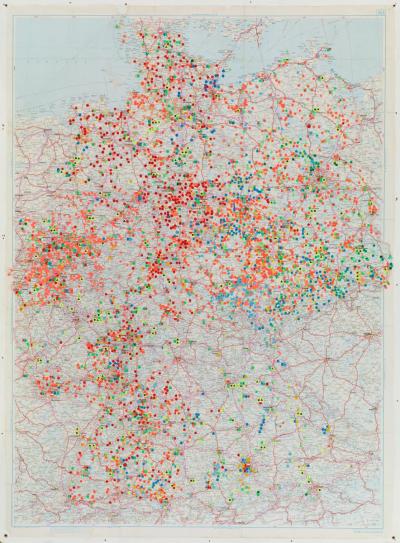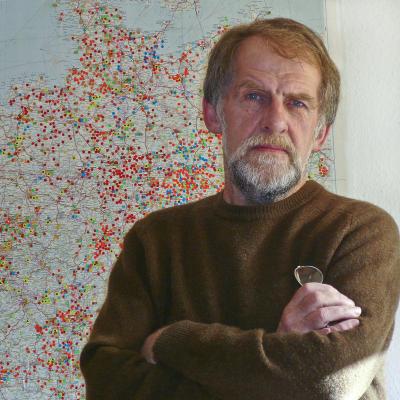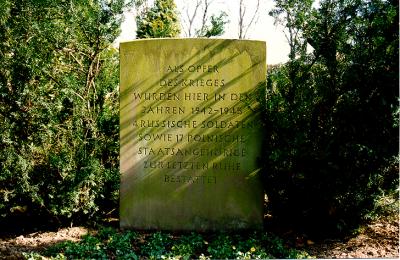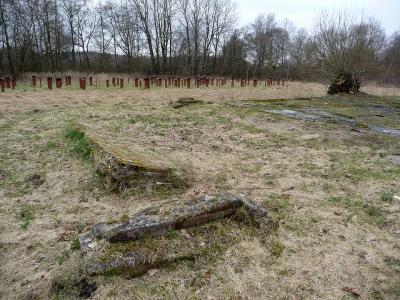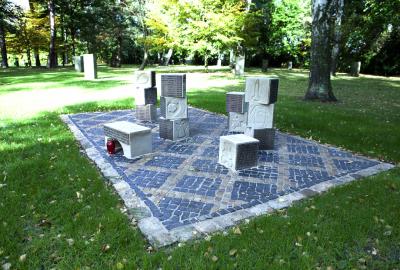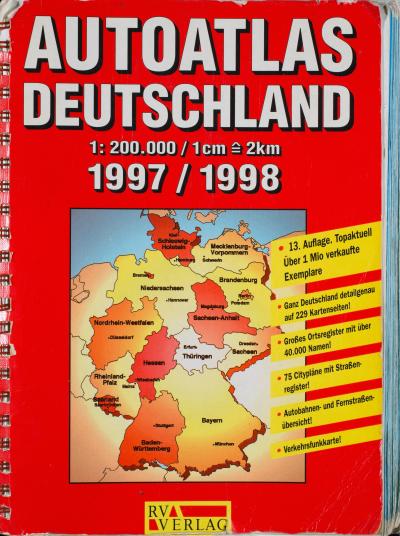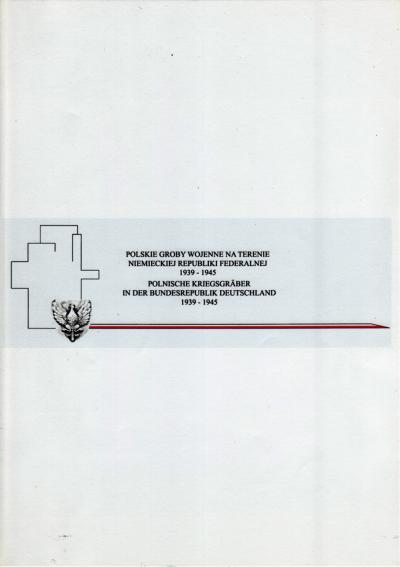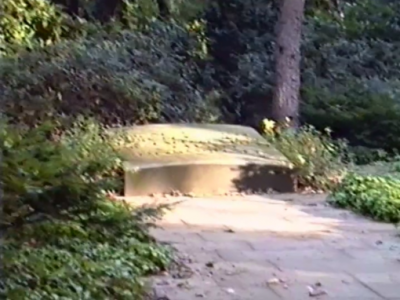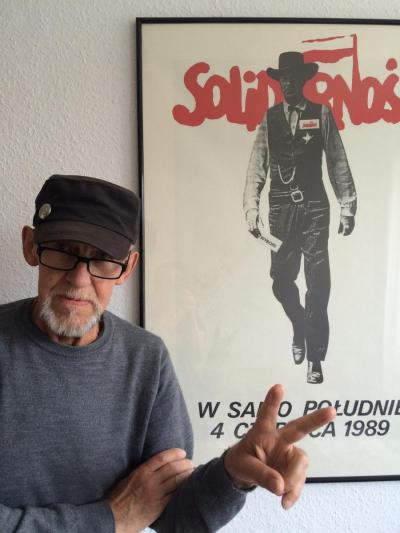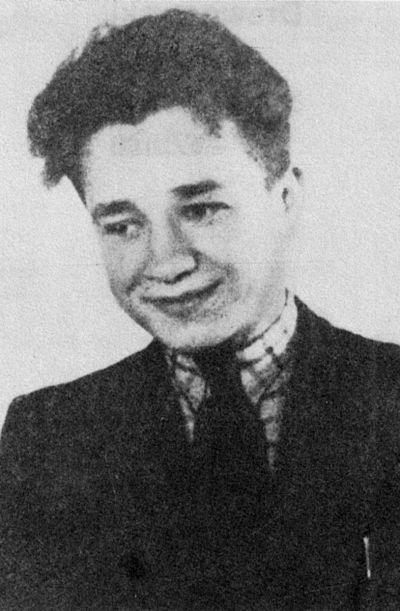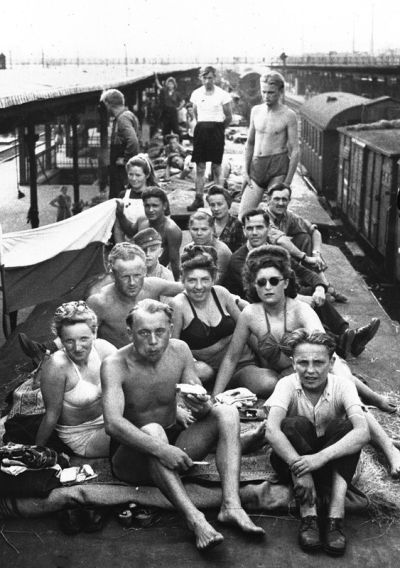Henryk Nazarczuk: Polish War Graves in Germany. A topography of death
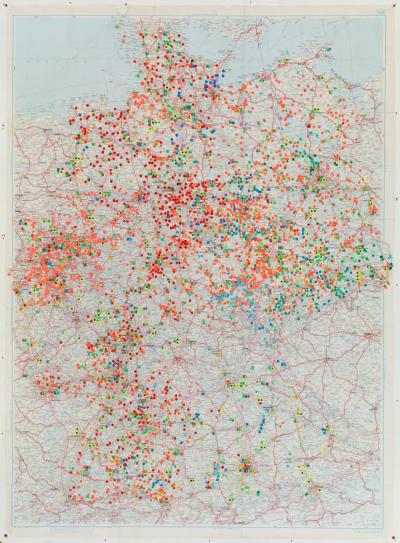
Polish War Graves in Germany. A topography of death.
A documentation of Polish war graves on German soil within the borders of the Federal Republic of Germany from 1939 to 1952.
For Małgorzata
To prevent the knowledge of the crime dying with the death of the criminal .
In 1945 my parents returned with their “war trophy” from forced labour in the German Reich: my father Aleksander with the very beautiful Maria and me in her belly, who had probably been conceived during one of the heavy bombing raids over Dresden. I was born in the cold autumn of 1945 in the scaled-down country of my forefathers. My mother was neither allowed the privilege of returning home nor of re-finding her family who had been reported missing since 17th September 1939 somewhere east of Stanisław[1] (in the Soviet Union since 1945 and now in the Ukraine). Hence my parents’ greatest achievement was to have survived the war.
Years after, when I was just able to peep over the edge of the table I overheard my parents talking about their memories with their friends whom fate had also allowed to return alive. Some of these were other forced labourers and one was a former prisoner of war who arrived on Sundays dressed in a soldier’s jacket dating back to 1939, and with a Konfederatka[2] on his head to which a metal eagle was attached. As time went on these meetings became rarer and the subjects of the conversation were different. The proportion of the conversations devoted to war sank in direct relationship to the rate at which I grew older. At some time I began to ask questions (I found a photo of my parents from the time they were working as forced labourers), but at the end of the 1950s and start of the 60s people who ask questions were mostly fobbed off with the words: “Oh, that’s not important, it’s just history”, or someone would tell a family anecdote like “Can you remember how auntie Maryśka polished all the farmers shoes till they gleamed…”
The years that followed were unquiet, interesting and full of events: Chancellor Willy Brandt falling on his knees in Warsaw; hearing the news of the planned compensation for forced labourers (my parents); or in 1976, “the jogging circuit [3] for striking workers” in Radom. The Second World War only showed up in the cinema and on television. Increasingly often and ever more precisely (second time around)[4] we learnt about the war crimes that were committed in the east after 17th September 1939.
I married. We were lucky enough to have two children: the hot summer of 1980 and “Solidarność”.
[1] German Stanislau, today Iwano-Frankiwsk.
[2] A traditional national head cover with a four cornered “cap“. Also known in Polish as a rogatywka .
[3] The sarcastic term for corporal punishment given to people in the Peoples Republic of Poland who opposed the government. Something like running the gauntlet in English.
[4] Polish, “drugi obieg“. A term used to describe unofficial, underground publications.
13.12.1981 - prison. The official explanation for the internment decision No. 4/81: “… would be a threat to the security of the country and public order because he helps to organise social unrest.” Accusations, threats, or both at the same time, were a part of normal everyday life: and in the end I found myself once more in the country of the people which my parents and their friends who had shared the same fate in the Third Reich, had been talking about.
In 1986 when I was employed by a stone restoration company in Hannover (it was a period in which many “unknown” criminals laid waste to Jewish cemeteries and destroyed them), I was working with my colleagues in Holzminden on the River Weser. At the edge of the Jewish cemetery that was tantamount to a battlefield (countless upturned partially destroyed gravestones), almost overgrown with plants, stood a gravestone that was larger and, in complete contrast to the others, in the form of a red sandstone slab in which the following German inscription had been chiselled:
“Between the years 1942 and 1945 four Russian soldiers and 17 Polish citizens were laid to rest here as victims of the war”.
I drew a sketch of the memorial site on a piece of paper and copied the inscription. The next day I took a few photos and went to the Cemetery Administration office (the Jewish cemetery was a part of the Christian cemetery) on a “mission of exploration” . Here I discovered that there were further graves of “forced labourers” in other parts of the cemetery.
It was clear that not everyone had returned from the war!
At the time I had no idea that the photos, sketches and copies of the names would be the start of my unpaid documentation. My notes began to pile up for I was often sent to North Germany on jobs during which I gathered information. My wife, Małgorzata, who loved to keep everything “in a nice orderly fashion” gave me my first notebook. I took this to mean that she not only agreed with my commitment to Poland but also tolerated the fact that I often came back late from work because I had visited a cemetery on the way.
We were gradually rewarded for our political work. The work in the Hannover “Solidarność” club began to die down for we’d knocked out communism with our own “KO”[5]. The number of notes and notebooks increased. Something had to be done. My wife went on a course. We bought our first computer. After a crash course at home the notes that we had written by hand and on our typewriter were finally taken into a new era.
[5] Short for “Komitet Obywatelski” (Engl.: Citizens’ committee), a grass-roots organisation in Poland at the time of “Solidarność”.
The documentation of Polish victims in the Second World War had begun, and indeed it comprised the victims who had died, or been murdered and buried in Germany in the borders created after 8th May 1945: these included soldiers who had been made prisoners of war during the invasion of Poland in September 1939, concentration camp prisoners, forced labourers, soldiers who had fought on the side of the Allies, combatants in the 1944 Warsaw uprising, soldiers in the Polish Peoples Army, and Polish men and women who had died in the Allied camps for “displaced persons” (DPs) after the end of hostilities.
A documentation was created, arranged according to countries and themes. Each entry consisted of a text and a photograph – they were still analogue at the time – pasted on a map, all in a plastic file and a folder. The number of folders grew rapidly. Many years later the General Consulate of the Republic of Poland in Hamburg offered me the opportunity of introducing myself and talking about my “hobby” to government representatives from the Republic of Poland work, during a meeting of Poles living in Germany. Through this I came to the Rada Ochrony Pamięci Walk i Męczeństwa ( Counsel for the Preservation of Battle and Martyrdom). From then on I regularly placed updated written documentation at the disposal of the council and the consulate. In return, valuable information was handed over to me from time to time. People also assured me that I was a patriot.
In 1994 the General Secretary of the Council, Adrzej Przewoźnik – he is no longer alive – suggested that I extend my interest to include the burial places of the soldiers in General Stanisław Maczek’s first Polish armoured division that were scattered all over the Emsland in Western Germany. I already knew about some of the cemeteries with the Maczeks’ graves because the Emsland was part of the territory covered by my employer. I accepted the suggestion of documenting the soldiers’ graves. After I had collected the necessary information with the help of the Polish General Consulate in Hamburg, I thought: “Now I really have something on my plate”. The whole project lasted four years. The complete documentation relating to the number of graves and their condition, based on recommendations given to me by (amongst others), the German authorities and the Consulate, was published in the council’s bulletin “Przeszłość i Pamięć” (The Past and Memorials), Number 1 (6), 1998. I then pushed this old fashioned paper documentation in the direction of a technology that was regarded as a modern miracle and which was light years ahead of all the things I could do. I’m talking about the internet. I updated and corrected them under the link “1 Polska Dywizja Pancerna” (1. Polish Armoured Division). 18 years later I was to enlarge it with a few details about the recommendations and suggestions I had put into practice. I am only too aware of the whereabouts of this “paper relic” after the so-called “dobra zmiana” (Change to the Good)[6]. Its destiny, along with the Council and the Instytut Pamięci Narodowej (Institute of National Memorials) has fallen victim to overblown patriotism.
[6] The election slogan of the Polish government that was responsible for changing the face of the country after November 2015.
The documentation of Polish victims in the Second World War had begun, and indeed it comprised the victims who had died, or been murdered and buried in Germany in the borders created after 8th May 1945: these included soldiers who had been made prisoners of war during the invasion of Poland in September 1939, concentration camp prisoners, forced labourers, soldiers who had fought on the side of the Allies, combatants in the 1944 Warsaw uprising, soldiers in the Polish Peoples Army, and Polish men and women who had died in the Allied camps for “displaced persons” (DPs) after the end of hostilities.
A documentation was created, arranged according to countries and themes. Each entry consisted of a text and a photograph – they were still analogue at the time – pasted on a map, all in a plastic file and a folder. The number of folders grew rapidly. Many years later the General Consulate of the Republic of Poland in Hamburg offered me the opportunity of introducing myself and talking about my “hobby” to government representatives from the Republic of Poland work, during a meeting of Poles living in Germany. Through this I came to the Rada Ochrony Pamięci Walk i Męczeństwa ( Counsel for the Preservation of Battle and Martyrdom). From then on I regularly placed updated written documentation at the disposal of the council and the consulate. In return, valuable information was handed over to me from time to time. People also assured me that I was a patriot.
In 1994 the General Secretary of the Council, Adrzej Przewoźnik – he is no longer alive – suggested that I extend my interest to include the burial places of the soldiers in General Stanisław Maczek’s first Polish armoured division that were scattered all over the Emsland in Western Germany. I already knew about some of the cemeteries with the Maczeks’ graves because the Emsland was part of the territory covered by my employer. I accepted the suggestion of documenting the soldiers’ graves. After I had collected the necessary information with the help of the Polish General Consulate in Hamburg, I thought: “Now I really have something on my plate”. The whole project lasted four years. The complete documentation relating to the number of graves and their condition, based on recommendations given to me by (amongst others), the German authorities and the Consulate, was published in the council’s bulletin “Przeszłość i Pamięć” (The Past and Memorials), Number 1 (6), 1998. I then pushed this old fashioned paper documentation in the direction of a technology that was regarded as a modern miracle and which was light years ahead of all the things I could do. I’m talking about the internet. I updated and corrected them under the link “1 Polska Dywizja Pancerna” (1. Polish Armoured Division). 18 years later I was to enlarge it with a few details about the recommendations and suggestions I had put into practice. I am only too aware of the whereabouts of this “paper relic” after the so-called “dobra zmiana” (Change to the Good)[7]. Its destiny, along with the Council and the Instytut Pamięci Narodowej (Institute of National Memorials) has fallen victim to overblown patriotism.
[7] The election slogan of the Polish government that was responsible for changing the face of the country after November 2015.
In 1995 there was an official ceremony to unveil the memorial stone for the inmates of Stalag VI in Oberlangen (Emsland), where I was given the opportunity to speak to the people who had been directly affected, the soldiers in the Warsaw Uprising. In order to prepare for this meeting I read a lot about the Warsaw Uprising and the groups of rebels who had been thrown wholesale into prison after the signing of the capitulation. I also knew of some of the localities in which the Stalags and Oflags was situated, and in which the soldiers of the Armia Krajowa (Home Army) had been interned alongside those who had been taken prisoner during the invasion of Poland in September 1939. Sad to say my meeting with the women members of the Uprising provided me with no really new knowledge. These women who described themselves as “dziewczyny oberlangówki” (Oberlangen girls) could scarcely keep pace with the programme of visits. From our brief conversations I only learnt that their imprisonment had been “difficult”. Happily, none of them had been killed in Oberlangen and none of them died. They didn’t even know of their fellow soldiers in the Home Army who died here under tragic circumstances after the war, and who had been buried nearby.
Ah well, I thought. They hadn’t had it easy in their “new socialist” fatherland. It was only later that I was disappointed. For many years I tried to advise the people living in Poland who had fought in the Home Army and taken part in the Warsaw Uprising, to stop thinking only about those who had died and were buried in Warsaw. In so far as this was concerned when I published the documentation in the internet I inserted the following appeal on the homepage of the Warsaw Uprising.
“It is right to carry out national memorial ceremonies. True, the ca. 400 graves scattered over German soil are only a fraction of those to be found in the Powązki cemetery (Cmentarz Powązkowski) and the cemetery in the Warsaw suburb of Wola (Cmentarz Wolski), but the approximate 400 soldiers from the Warsaw Uprising make up a whole battalion whose members often died of their wounds during their imprisonment or were killed in concentration camps. Those people who found their final rest in these graves have earned the right to be honoured in national memorial ceremonies because of their armed resistance. For this reason we are adding the forgotten graves to all those who are annually honoured and visited in the cemeteries of Powązki and Wola every day, and those memorial places in the streets of Warsaw to honour the heroes of the city.”
Happily my disappointment was compensated by a friendly reaction from a woman worker in the Muzeum Powstania Warszawskiego (Museum of the Warsaw Uprising). I had got to know her in one of the German cemeteries, and she gave me a list of around 100 names of people who had taken part in the uprising and who had died and been buried in Germany. I am extremely grateful for the information she gave me in a matter which had been the reason for my huge disappointment: the lack of any “interest” in Poland for these graves.
For example this is what happened to the “lost” camp cemetery at Stalag XIA Altengrabow, a graveyard flattened by Russian tanks (it was a Russian military training area until the 1990s), where 52 soldiers of the Warsaw Uprising who had been captured after the invasion of Poland in 1939 found their last resting place. After their last battle for their fatherland they died for it in prison. Up until the present day their fatherland has demonstrated its “gratitude” by forgetting them. I have the impression that none of the two parties (German-Polish Dialogue) is interested in finding and uncovering the graves.
Then again, other victims are resting in unknown places, often beneath a carefully kept mound of grass, but without any indication of who is buried there: this beside a thoughtfully equipped, exemplary well-kept barracks for soldiers in the German army (Husum) and amongst countless similar “small grassy areas”. They were buried as forced labourers or simply as “Poles”, quite commonly with their names wrongly spelled and lacking any further personal details. After the end of the war the Western Allies exhumed their servicemen and women who had fallen in battle or died in captivity and buried them anew in the soil of their fatherland, or created special military cemeteries for them, like the Dutch in Hamburg and Hannover. Even the Russians have put some of their graves in order by forcing the local authorities to create Russian mass cemeteries on German soil; and that although they had declared their prisoners of war to be traitors because they had surrendered at the time. Seen in such a light very many Russians and very many Poles have remained behind in the country of their captivity.
All well and good, the political and economic situation in post-war Poland between 1945 and 1989 can explain a few things, but not everything. Those people who escaped death in German captivity had scarcely any choice about where they lived after the war: some of them went west; others remained in Germany and took advantage of the help provided by the Allied forces in the Western occupied zones. Those who returned to Poland soon discovered what awaited them in freedom under the “occupation” of their Eastern allies. The “idyllic idea” of life in the protection of the Peoples Republic ended abruptly as soon as it revealed itself. There followed arrests and trials that often ended with death sentences, the intimidation and persecution of members of the Home Army as well as attempts to denigrate their heroism and wipe them out of national memory.
There are only a few initiatives in Germany, which recall the participants in the Warsaw Uprising, for example in the Hamburg district of Harburg. These were set up in the post-war years by members of the Uprising who had remained here. Regrettably, however, no lists were compiled of the graves of comrades (both men and women), buried in the land of their captivity, and none have been passed on of the graves that have fallen into disrepair in the course of time. With each new reform of the War Graves Law (GräbG) more and more cemeteries are abolished and fall into oblivion. The Polish exile government and the Organisation of Combatants in the Home Army, which still exist in countries to which the soldiers of the Uprising emigrated, have taken no initiatives and shown no interest in the subject. No one is standing up for these graves! Hence I was full of shame when people in some cemeteries said to me: “You’re the first Pole who has ever asked about these graves.”
The 4th June 1989[8], an important day in Poland’s recent history, when men and women appeared at various official occasions wearing medals on their breasts and red and white armbands carrying the symbol of “Polska Walcząca” (Battling Poland), aroused hopes for a better future for the soldiers in the Uprising who had disappeared and been forgotten in the land of their captivity. But in reality nothing changed in this respect. Whilst they were serving other, often political, causes their comrades demonstrated that everything was “quiet on the Western front”, a fact that automatically triggered off the creation of the Association.
[8 The day of the first semi free elections in Poland that ushered in the end of communism.
In 2005 journalists from the “Rzeczpospolita” newspaper and the “Zet” radio station joined forces to look for the graves of members of the Uprising who had died in Essen. After their article was published people who should have raised their voices at least 10 years earlier, wrote to the newspaper: “We had no idea of the situation nor that there are so many”, as one of the principal people who must have known about it honestly admitted in the “Rzeczpospolita”. Ideas came thick and fast: “ ...we’ll set up a commission, we’ll send soldiers and Boy Scouts there, we’ll erect as many crosses as possible there, we’ll supply the Polish diaspora with large financial donations, but best of all we should ...” etc. (“Rzeczpospolita”, August 2006).
The graves of soldiers from the Warsaw Uprising only make up a minor part of the whole documentation but for me they are particularly painful. True, the struggle for the last cemetery containing the graves of the rebels in Altengrabow, which began in the middle of the 1990s, has not been completely abandoned; but I am powerless in the face of the reality that there was once a cemetery there and it no longer exists. This reminds me of a fragment from a poem that a young rebel wrote shortly before the capitulation (the quotation can also be found in my documentation on the Internet):
“A historia okłamie nas jutro, groby nasze wyrówna ktoś obcy... ”
(And tomorrow history will tell us lies, strangers are levelling our graves...)
(http://www.polskienekropolie.de).
Now, after receiving a suggestion from „Porta Polonica” in 2016 that we should work together, I am sitting somewhat “terrified” in front of my computer because I have collected so much during the past 30 years. The original collection of information on Polish War Graves that was later called a “documentation” only came into being because of the graves I accidentally discovered outside my professional activities. Because of the information gathered from official authorities, organisations and publishers about sites, numbers and the conditions of the graves, as well as communications and photographs of cemeteries sent to me by individual people who wrote things like: “We took a walk and visited the local cemetery where we discovered Polish War Graves”, the collection has grown and grown. Sometimes they wrote: “We took the enclosed photos and are sending them to you because they might be useful.” Yes, they are very useful and now I have a huge circle of people who communicate with me by post. Hence I also receive information from people asking me for help in searching for a grave or information on the circumstances of the death of a close or distant relative. On the plus side I have answered hundreds of letters and made many positive experiences including the discovery of graves like those of the soldiers in the Warsaw Uprising, as well as expressions of gratitude like the following: “…… we should like to thank you for helping our family to put our past in order”.
My documentation began in spring 1986 when I first made some notes in Polish on a piece of paper of the details on the “other” graves in the Jewish cemetery in Holzminden, a German town on the River Weser.
Up until the day I made contact with “Porta Polonica”, I have laboriously built up a complete archive over 30 years of voluntary activity in the private time available to me, with the support and later active help given to me by my family (above all my wife). On the map of Germany, on which I have stuck coloured dots showing the status of a grave, there are now around 7000 markings, of which over 4000 are definite, verified and documented sites containing (or that once contained) Polish graves from the Second World War. The other dots give information about camps or events like places of execution or places where people were killed during the “death marches”. Here further details have still to be collected.
Furthermore a few thousand photos – at the start analogue and later digital – make up a part of the documentation, alongside a few hundred (I haven’t counted them) names of Polish war victims noted in the “classic” style (i.e. on paper), which I received from official sources or copied in official offices most of them in Lower Saxony, the region where I live. A few dozen of these lists, above all the comprehensive lists of victims in concentration camps are now digitally accessible. In addition the documentation contains countless copies of documents and further information that I received from officials or private persons, not forgetting notes, sketches of sites and cuttings from newspapers and other publications. And something else: in the 30 years in which I sought for information on the subject in academic publications, like a man with a parched throat in the desert, I have established that such sources are a rarity even in Germany, not to speak of Poland. Nonetheless a relatively large library of sources has been created containing over 250 titles.
Enough of my own stuff! True to the old Polish motto: “Koń, jaki jest, każdy widzi” (The horse is how it is, anyone can see that),[9] a documentation that anyone can call up on the internet and use in any way they choose to, needs no special publicity.
Up to now I’ve never really thought about my age. Now I realise that I am growing old, I’m not in the best of health, and the world is also a few years older, also in Poland where the documentation is due to go into its “well earned retirement”. Only recently I had no doubt about this but after the awful experiences with the older paper documentation in Poland which is probably lying around somewhere gathering dust in an unknown cellar (after the death of Andrzej Przewoźnik I never succeeded in finding out the exact location), I’m looking for another place to store my collection. The fact that people assured me, then and now, that I was a “patriot” was no guarantee that the paper documentation would find a place of rest and preservation. With a few exceptions – Hamburg and, out of a feeling of duty, Hannover; as well as Munich at the beginning of my activities – Polish organisations in Germany have shown no special interest in it.
That said, after several hours of conversation with representatives of “Porta Polonica” it has now been firmly decided to find a suitable secure place for the documentation on their homepage. Thus it will not be consigned to “retirement” but, quite the opposite, can now experience another lease of life in this new dynamically developing medium.
My interest in war graves has been fired by the date of my birth, by the vivid recollections of my two grandfathers and my father, by the reminiscences of Poles in the post-war years and by my own interest in history. It is no accident that I saw my first Polish gravestone in Germany many years ago and now I know of thousands.
Henryk Nazarczuk, January 2017
The footnotes should solely be regarded as a help to understanding the translation and making it easier to read.
HYPERLINK
http://www.polskienekropolie.de
[9] The motto comes from the Polish priest, Benedykt Chmielowski (1700-1763), the author of the first Polish encyclopaedia. It roughly means: something is so obvious that you don't have to talk about it.
